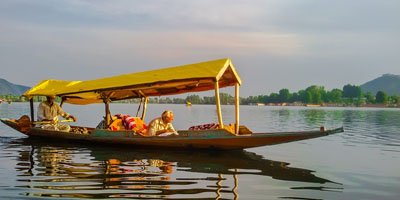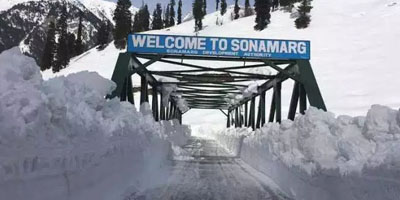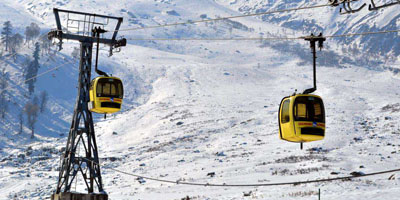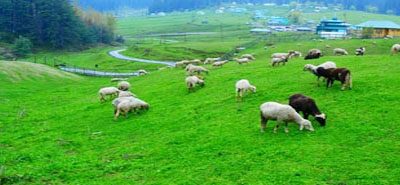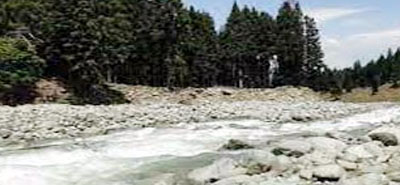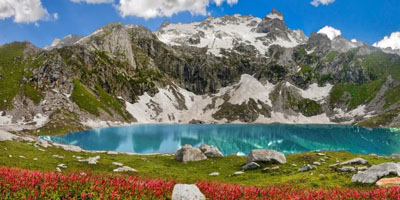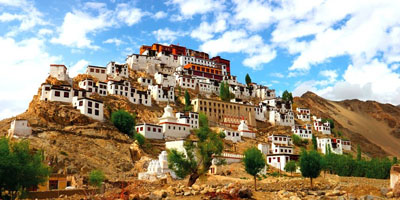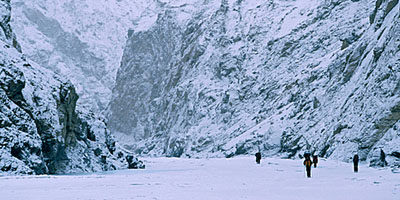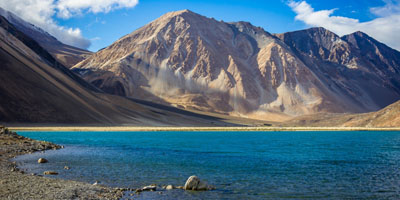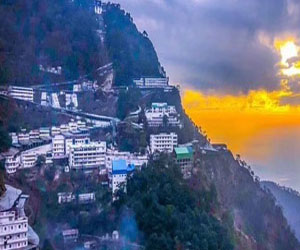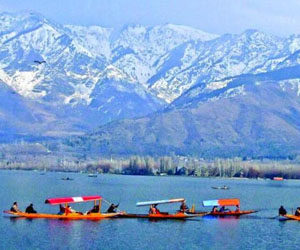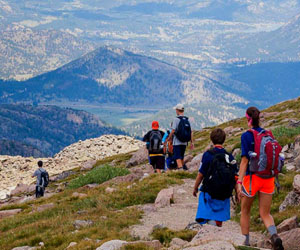
| LAKES & MOUNTAINS - JAMMU & KASHMIR Leh - Ladakh is the largest province within the North Indian State of Jammu and Kashmir, covering approximately 60,000 square miles (100,000 sq. km). It is surrounded and bisected by some of the highest mountain ranges in the world. Running in a generally northwest to southeast direction through Ladakh, the great Himalayan Range separates the Vale of Kashmir from Ladakh. We have various Tour Packages for your ready reference, though we believe on Tailor Made Itineraries for your scheduled trip to Ladakh and kashmir. 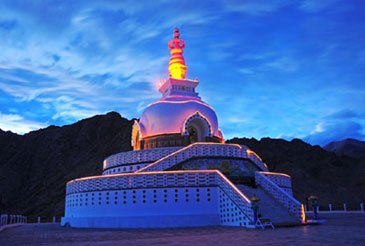 It
is located to the north of the Indus River at an elevation of 3600m above
the sea level. The town is dominated by the Namgyal Tsemo (victory peak)
built by King Tashi Namgyal in 16th century, as a royal residence and the
nine-storey Namgyal Palace built by King Sengge Namgyal on his victory in
reunification of the Upper and Lower Ladakh in 17 century. Leh became the
capital of Stod (upper Ladakh) during the reign of King Graspa Bum- Lde,
who ruled Ladakh from 1400 to 1430 AD. In the later period, Leh became an
important center for trade in Central Asia, along the Indus Valley between
Tibet to the east, Kashmir to the west and ultimately between India and
China It
is located to the north of the Indus River at an elevation of 3600m above
the sea level. The town is dominated by the Namgyal Tsemo (victory peak)
built by King Tashi Namgyal in 16th century, as a royal residence and the
nine-storey Namgyal Palace built by King Sengge Namgyal on his victory in
reunification of the Upper and Lower Ladakh in 17 century. Leh became the
capital of Stod (upper Ladakh) during the reign of King Graspa Bum- Lde,
who ruled Ladakh from 1400 to 1430 AD. In the later period, Leh became an
important center for trade in Central Asia, along the Indus Valley between
Tibet to the east, Kashmir to the west and ultimately between India and
ChinaFamous Monasteries in Leh Ladakh Shanti Stupa The Shanti Stupa is white-colored domed-shaped structure, located in Chandspa which looks extremely beautiful during night when it is illuminated. This peace pillar was built a 'peace sect' of Japanese Buddhist organization to celebrate the completion of 2500 years of Buddhism and for the promotion of world peace. It was inaugurated by His Holiness, the Dalai Lama in 1985. This pillar is known for its gilt panels depicting the life stories of Lord Buddha. It is just 5 kms away from the main city of Leh and is surrounded the traditionally built houses of the locals and snow-covered mountains. Take the steep slights to reach the Stupa that offers beautiful sunrise and sunset views. Leh Palace Leh Palace known as the 'Lhachen Palkhar' is a former royal palace of the Leh Kingdom. Located in Leh city. It is one of the biggest tourist attraction of Leh city. The 17th century Palace, Leh Palace is also one of the tallest buildings of its time with nine story's. The palace provides spectacular views of Stok Kangri and the Ladakh mountain range as well as town and surroundings Lamayuru Monastery 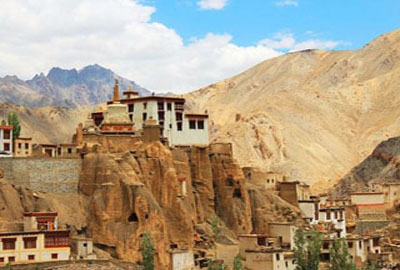 Lamayuru
Monastery is a Tibetan Buddhist Monastery perched at an altitude of 11520
ft., the monastery is one of the fascinating places to visit in Ladakh.
The oldest gompa is also one of the largest monasteries in Ladakh famed as
Tharpa Ling which means the 'place of freedom'. Nearly 150 monks belong to
the monastery and 30-40 still reside at the gompa belonging to the
Red-Sect of Buddhism. The monastery lures spirituality learners and
tourists who wish to spend some time at a beautiful location amidst the
sacred aura. The gompa also serves as the meditation center. Tranquil
ambiance and scenic location of the monastery is mesmerizing. Lamayuru
Monastery is a Tibetan Buddhist Monastery perched at an altitude of 11520
ft., the monastery is one of the fascinating places to visit in Ladakh.
The oldest gompa is also one of the largest monasteries in Ladakh famed as
Tharpa Ling which means the 'place of freedom'. Nearly 150 monks belong to
the monastery and 30-40 still reside at the gompa belonging to the
Red-Sect of Buddhism. The monastery lures spirituality learners and
tourists who wish to spend some time at a beautiful location amidst the
sacred aura. The gompa also serves as the meditation center. Tranquil
ambiance and scenic location of the monastery is mesmerizing.Lamayuru is the oldest and one of the largest monasteries in Ladakh. As per legends, Lamayuru's valley was a clear lake at the time of the Sakyamuni. The lake was the dwelling place of the holy serpents. The Bodhisattva Madhyantaka made a prediction that the lake will be emptied and a monastery will be built here. Naropa, a Buddhist scholar visited Ladakh in 11th century and spent many years meditating in a cave. Naropa then caused a split in the surrounding hillside and due to this the lake emptied. Thereafter, Naropa found a dead lion covered by the waters of the lake. Naropa built the first temple on this spot and named it as the Singhe Ghang (Lion Mound). Alchi monastery Alchi monastery, located in the Alchi village in Leh, was built by the great translator Guru Rinchen Zangpo between 958 and 1055. Today it is being monitored by Likir Monastery. This monastery is actually a complex of temples consisting of 4 separate portions that has monuments built at different times. The main complex has three temples- gTsug-lag-Khang (main temple), 'Jam-dpal lHa-Khang (Manjushri temple) and Dukhang (assembly hall). Alchi monastery is one of the most well-known ones. The walls of the site are adorned with paintings depicting the details of Hinu kings as well as the teaching of Buddhism. Hemis Monastery  Hemis Monastery is a Tibetan monastery belonging to the Drukpa Lineage. Counted as one of the iconic monasteries in Ladakh, Hemis is perched on a mountain along the west bank of Indus River. People eagerly await to marvel at the numerous paintings or Thangkas that are carefully preserved here and are displayed on the famous Hemis Festival. A visit to the Hemis Monastery is one of the highlights of planning holidays in Ladakh. The ancient Hemis monastery is said to be have existed before the 11th century. Naropa, the teacher of the translator Marpa and the pupil of the yogi Tilopa, are regarded as the founding fathers of the Kagyu-lineage of Buddhism, with, Hemis is its main seat. The first incarnation of Stagsang Raspa Nawang Gyatso founded the monastery in 1630 when he was invited to Ladakh by the King Singay Namgyal. Matho Monastery Matho Monastery is a Tibetan Buddhist monastery built under the Saskya Monastic Establishment. It was constructed around 500 years ago. It was established by Lama Dugpa Dorje in 1410, who belongs to Sakya order. It houses a marvelous collection of ancient Thangas and known for its Matho Nagrang Festival. It is an annual festival which takes place in the first half of March. It is a nice place where you can understand Buddhist teachings and philosophies. The nearby attraction of this place is Stakna Gompa. Rangdum Gompa  Rangdum Gompa is situated halfway between Kargil and Padum. It was founded by Losang Geleg Yeshe Drogpa in the 18th century. It rises above a centrally ascending mountain, established around the diverged route of a mountain stream. It appears like an ancient fortification, which stands as a guardian of a mystical mountain valley. It is located alongside Julidok village and around 25 kilometers from the Pensi La pass which leads to Zanskar. This monastery is home to around 30 monks and monasteries. Rizong Gompa Rizong Gompa, also known as Rhizong monastery belongs to Gelugpa or Yellow Hat sect of Buddhism is situated on the hilltop of a rocky valley to the north of river Indus. It is also known as the Yuma Changchubling in Ladakh region. Established at Ri-rdzong in 1831 by Lama Tsultim Nima under the Gelukpa order, today it has around 40 monks who have to abide by very strict rules and regulations. It is also famous as 'the Paradise For Meditation'. Sankar Gompa Sankar Gompa, or monastery, is yet another beautiful monastery in Ladakh located at a distance of around 3km from the main town of Leh. You should visit this monastery during your tour to Ladakh, not just for its incredible architecture but also because it's a treasure-trove of history and art. Sankar Monastery is believed to be a subsidiary of Spituk Monastery, with the same Lama presiding over it. Diskit Monastery  Diskit Monastery, also known as Deskit monastery is not only the oldest but also the largest Buddhist Gompa in the Nubra Valley, Ladakh. The prayer hall of the monastery consists of a statue of Maitreya Buddha, various images of other guardian gods as well as huge drum. This monastery is of the Gelugpa sect (Yellow Hat) of Tibetan Buddhism, founded by Changzem Tserab Zangpo, a disciple of Tsong Khapa, founder of Gelugpa, during the 14th century. The monastery's cupola is same as the Tashilhunpo Monastery of Tibet.
Shey Monastery is reckoned as one of the popular monasteries in Leh
Ladakh. Also known as Shey Palace or Shey Gompa, the monastery is famous
for housing a 3-storeyed huge copper with gilded gold idol of seated
Shakyamuni Buddha. The statue is counted as the second largest idol in
Ladakh.
Stakna Monastery |
Why Book with Us?
Copyright 2021 by Maa Sharda Holidays. Design by-Indian Designers Inc.












